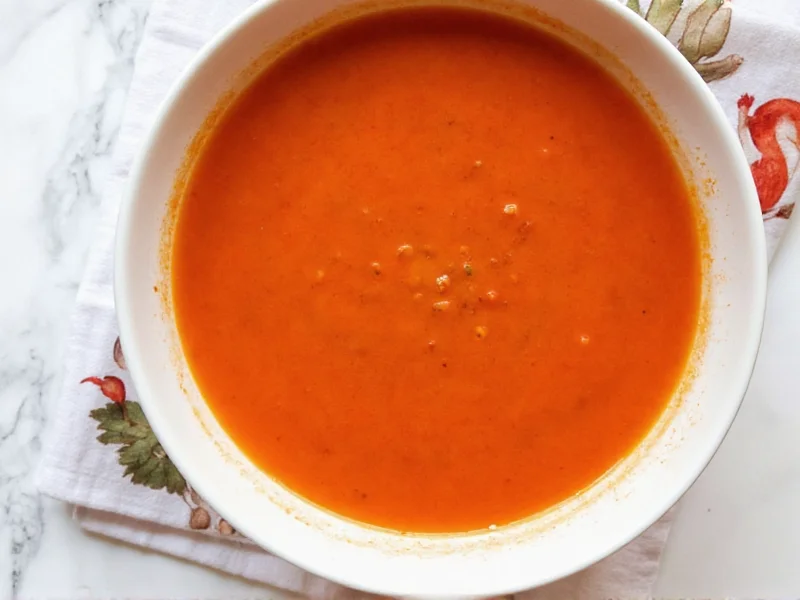Why This Simple Tomato Soup Recipe Works
Homemade tomato soup often intimidates beginners, but this streamlined approach eliminates unnecessary steps while maximizing flavor. Unlike canned alternatives loaded with preservatives, this recipe uses pantry staples to create a vibrant, nutrient-rich meal. The magic happens through proper layering of flavors—starting with sautéed aromatics and finishing with a touch of acidity that brightens the natural sweetness of tomatoes.
Essential Ingredients for Perfect Tomato Soup
Quality ingredients make the difference between平淡 and extraordinary soup. Here's what you need:
| Ingredient | Why It Matters | Smart Substitutions |
|---|---|---|
| 28-ounce can whole peeled tomatoes | Whole tomatoes contain less sodium and more natural flavor than diced varieties | Fire-roasted tomatoes for smoky depth |
| 1 yellow onion, chopped | Provides foundational sweetness without overpowering | Shallots for more delicate flavor |
| 3 garlic cloves, minced | Adds aromatic complexity when properly sautéed | 1 teaspoon garlic powder in a pinch |
| 2 tablespoons olive oil | Carries flavors and creates rich mouthfeel | Avocado oil for higher smoke point |
| 3 cups vegetable broth | Builds depth without dairy | Chicken broth for non-vegetarian version |
| 1 teaspoon dried basil | Complements tomato flavor without overpowering | Fresh basil (1/4 cup chopped) added at end |
Step-by-Step Preparation Guide
- Sweat the aromatics: Heat olive oil in a 4-quart pot over medium heat. Add onions and cook for 5-7 minutes until translucent but not browned. Stir in garlic and cook 1 minute until fragrant.
- Build the base: Pour in tomatoes (with juices) and broth. Use kitchen scissors to roughly chop tomatoes directly in the pot. Add basil, 1/2 teaspoon salt, and 1/4 teaspoon black pepper.
- Simmer for depth: Bring to a gentle boil, then reduce heat to low. Cover and simmer for 20 minutes, stirring occasionally.
- Blend to perfection: Use an immersion blender to puree until smooth (or carefully transfer to countertop blender in batches).
- Final seasoning: Taste and adjust with salt, pepper, or 1 teaspoon balsamic vinegar to enhance tomato flavor.
Pro Tips for Flavorful Results
Avoid these common pitfalls that turn good tomato soup bad:
- Don't rush the onions: Properly softened onions (not browned) create sweetness without bitterness
- Acid balance is key: A splash of balsamic vinegar or lemon juice at the end brightens flavors
- Texture control: For thicker soup, simmer uncovered 5-10 minutes longer; for thinner, add broth
- Blend while hot: Immersion blenders work best with hot (not boiling) soup for smoothest texture
Customization Options for Every Diet
This basic recipe adapts beautifully to different preferences:
- Creamy version: Stir in 1/4 cup coconut milk or cashew cream (no dairy needed)
- Roasted tomato variation: Broil canned tomatoes on baking sheet 10 minutes before adding
- Protein boost: Add 1/2 cup cooked lentils or white beans while simmering
- Spicy kick: Include 1/4 teaspoon red pepper flakes with the garlic
Storage and Reheating Instructions
Tomato soup actually tastes better the next day as flavors meld. Store properly for maximum freshness:
- Cool completely before transferring to airtight containers
- Refrigerate for up to 5 days or freeze for 3 months
- Reheat gently on stove over medium-low heat (avoid boiling)
- Add a splash of broth when reheating frozen portions
Nutritional Benefits
One serving (1.5 cups) provides approximately:
- 140 calories
- 7g fiber (28% daily value)
- Rich in lycopene, vitamin C, and potassium
- Naturally low in sodium (control with broth choice)
Frequently Asked Questions
Can I make simple tomato soup without canned tomatoes?
Yes, but fresh tomatoes require more preparation. Use 3 pounds ripe tomatoes, blanched and peeled. Simmer 30-40 minutes to concentrate flavor since fresh tomatoes contain more water than canned.
How do I fix tomato soup that's too acidic?
Balance acidity with 1 teaspoon sugar, honey, or grated carrot. A small pinch of baking soda (1/8 teaspoon) also neutralizes acidity without altering flavor significantly. Add gradually while tasting.
What's the best way to thicken tomato soup naturally?
Simmer uncovered for 5-10 minutes to reduce liquid. Alternatively, blend in 1/4 cup cooked white beans or potatoes for creaminess without dairy. Avoid flour roux for the simplest preparation.
Can I make this recipe in an Instant Pot?
Absolutely. Use Sauté function for onions and garlic (5 minutes), then add remaining ingredients. Pressure cook on High for 8 minutes, followed by natural release for 10 minutes before blending.
What are ideal toppings for basic tomato soup?
Keep it simple with fresh basil, cracked black pepper, or a drizzle of good olive oil. For texture contrast, add croutons or grilled cheese crumbles. Avoid heavy creams that mask the clean tomato flavor of this simple homemade version.











 浙公网安备
33010002000092号
浙公网安备
33010002000092号 浙B2-20120091-4
浙B2-20120091-4